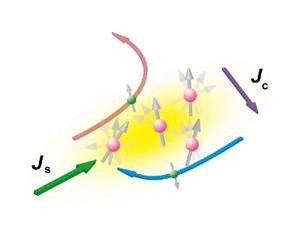Conversion between currents of charge (Jc) and spin (Js) depends on the configurations of four magnetic moments at a time.
The spin Hall effect (SHE) enables us to create spin current in non-magnetic materials without using ferromagnetic materials. It is a crucial element in the central idea behind spintronics, that of manipulating currents of spin instead of currents of charge. Since the first experimental report on the SHE in semiconductors in 2004, the phenomenon and its mechanism have been intensively studied to find out more efficient and economical methods of generation of the spin current, both in semiconductors and metals.
The inverse process of SHE (ISHE) is similarly recognized as a key step to be mastered in order to convert the spin current back into a charge current. So while both the SHE and its inverse are important for the potential applications, there are few examples of their use as an electrical detector of more fundamental properties of condensed matter.
In an article just released in Nature communications, scientists from the University of Tokyo, the Japanese Atomic Energy Authority and the ILL propose a new way to harness the ISHE as a probe of nonlinear spin fluctuations in the vicinity of the magnetic phase transition of a magnetic metal.
This work provides a new probe which has shown to be applicable to nanowires, with a sensitivity to a tiny magnetic moment orders of magnitude smaller than that which could be seen by a conventional SQUID magnetometer.
More information: Nature Comms., 11/09/2012 doi: 10.1038/ncomms2063 . www.nature.com/ncomms/journal/ … full/ncomms2063.html
Journal information: Nature Communications
Provided by Institut Laue-Langevin






















